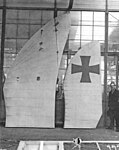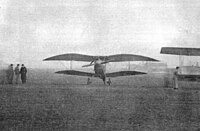Aviatik D.II
| D.II | |
|---|---|

| |
| Profile photograph of the Aviatik D.II with its original wings | |
| Role | Fighter aircraft |
| Manufacturer | Aviatik |
| First flight | 1916 |
| Number built | 1 |
The Aviatik D.II was a prototype German single-seat biplane fighter aircraft built by Aviatik during World War I. Only a single aircraft was built, but no production order followed. It later had its conventional wings replaced by bird-shaped wings and has been referred to as the Geest Fighter in this guise. Further development was discontinued.
Background and description
[edit]Aviatik had been building the Halberstadt D.II fighter under license as the Aviatik D.I, but decided to build a prototype of their own design in late 1916. The D.II was a single-bay, staggered-wing biplane with fabric-covered wooden wings and a single cockpit. The aircraft was powered by a single water-cooled, 160-horsepower (120 kW) Mercedes D.III six-cylinder inline engine using a two-bladed fixed-pitch propeller. The forward fuselage was built from steel tubes with a metal skin while the wooden rear fuselage was skinned with plywood. It was armed with a pair of fixed, synchronized 7.92 mm (0.312 in) LMG 08/15 machine guns in the forward fuselage. The prototype's performance was mediocre and it was not ordered into production.[1][2]
Geest Fighter
[edit]Before the war's beginning in 1914, Dr. Waldemar Geest designed and built a series of six monoplanes using his Seagull (Möwe) gull wing design that was intended to compensate for forward or lateral gusts of wind "by a varying angle of incidence and dihedral throughout the wing planform".[3] In 1917, the conventional wings that had been fitted to the Aviatik D.II were replaced by staggered wings designed by Geest with curved leading edges and raked ailerons on the upper wing.[4] During testing, the single-bay aircraft had a maximum speed of 160 kilometres per hour (99 mph) and reached a height of 3,500 metres (11,500 ft) in 17.5 minutes, but further development was not continued.[5][6]
-
Profile photograph of the Aviatik D.II with the Geest wing
-
The upper Geest wing (left) and the lower (right)
-
Frontal view of the Geest fighter
Specifications
[edit]Data from Aviatik Aircraft of WWI: A Centennial Perspective on Great War Airplanes;[1] The Complete Book of Fighters: An Illustrated Encyclopedia of Every Fighter Built and Flown[2]
General characteristics
- Crew: 1
- Length: 6.82 m (22 ft 5 in)
- Wingspan: 8.84 m (29 ft 0 in)
- Height: 2.87 m (9 ft 5 in)
- Powerplant: 1 × Mercedes D.III 6-cylinder water-cooled in-line piston engine, 120 kW (160 hp)
- Propellers: 2-bladed fixed-pitch propeller
Performance
- Maximum speed: 150 km/h (93 mph, 81 kn)
- Time to altitude: 7.2 minutes to 1,000 m (3,300 ft)
Armament
- Guns: 2 × fixed, synchronized 7.92 mm (0.312 in) LMG 08/15 machine guns in the forward fuselage
References
[edit]Bibliography
[edit]- Gray, Peter & Thetford, Owen (1987) [1970]. German Aircraft of the First World War (2nd ed.). London: Putnam. ISBN 0-85177-809-7.
- Green, William & Swanborough, Gordon (2001) [1994]. The Complete Book of Fighters: An Illustrated Encyclopedia of Every Fighter Built and Flown (Revised and Updated ed.). London: Salamander Books. ISBN 1-84065-269-1.
- Herris, Jack (2023). Aviatik Aircraft of WWI: A Centennial Perspective on Great War Airplanes. Great War Aviation Centennial Series. Vol. 10 (2nd ed.). n.p.: Aeronaut Books. ISBN 978-1-953201-59-1.
- Herris, Jack (2020). German Aircraft of Minor Manufacturers in WWI: A Centennial Perspective on Great War Airplanes. Gret War Aviation Centennial Series (49). Vol. 1: Alter to Korn. n.p.: Aeronaut Books. ISBN 978-1-935881-85-8.



